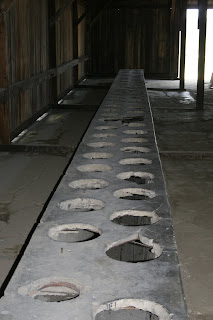 Birkenau - Birkenau - Birkenau - a name never to be forgotten. An immense camp, where once you entered, like Auschwitz, you never left alive. Here, the life expectancy was either hours or an average maximum of fifty six days.
Birkenau - Birkenau - Birkenau - a name never to be forgotten. An immense camp, where once you entered, like Auschwitz, you never left alive. Here, the life expectancy was either hours or an average maximum of fifty six days.
Not the most awe inspiring entrance, a single gate through which the Nazi trains brought in their poor and unsuspecting victims. The carriages, packed tight with Jews were stopped at the unloading platform and their human cargo unloaded by many of the 4000 guards who were stationed between the two camps. Once out in the open and lined up they were slowly taken forward for examination by the "Camp Doctor", who with a simple gesture from his finger sentenced them to a quick death or a slow death. There is apparently a photograph of him in action and the most poignant bit of the photo is a shadow on the ground which shows his finger pointing. His decision sent the elderly, children, many women and the infirm on a 300m walk onwards straight into the waiting gas chambers in the four incinerators in the camp. Possibly the less fortunate who were deemed capable of working were sent right or left into the male and female barracks, 400 people in each, three to a bunk, literally no heating, very little food, no water other than that in the drainage ditches - toilets, 200 in a hut where the inmates were allowed only one visit a day for minutes. these toilets were no more than cess pits and it was little wonder the camp was ridden with disease.

Those who were sent to the barracks were there to join the workforce in the nearby factories, etc. The camps were sited in the middle of a large industrial complex and the prisonwers were marched out daily. The camps were not identified till later in the war as the Allies did not know what they were due to them being hidden amongstthe industrial sites. The actual camos were surrounded by air raid shelters so that the guards could save themselves in the event of a bombing.








As I say the life expectancy was only 56 days for the strong, but for the others were was no escape, their belongings were taken from them as they walked unknowingly from the reception centre towards the four gas chambers, I wonder what they thought as they approached, they were led, in their hundreds into the "showers" many given towels to make the farce look real, undressed and walked into the massive shower units where once inside the Cyclon B gas pellets were poured into the rooms killing those below.
Once dead the bodies were checked and all gold fillings, artificial limbs removed, etc, and then fed into the four incinerators which worked non stop 24 hours a day to dispose of them.
As the end of the World War 2 drew near and the allies arrived to relieve the Camps the Germans started to try and destroy the evidence of their horrendous and inhumane wrong doings by setting fire to the barracks and blowing up the gas chambers and incinerators with explosives, leaving only what is now visible.
 For the present day visitor, if that is the right word !! because many come to pay their respects, to put to rest memories, to come to terms with what happened there, hard as it may be - you can see the steps leading down into the shower/gas chambers - the roof now collapsed in, and the rubble from the chimneys of the incinerators. it is a place which even on a sunny day can haunt the heart and still deep feelings of anger, pity and distress. I could not even begin to imagine the horrors those poor people went through there in the middle of winter - trudging trough the snow to certain death.
For the present day visitor, if that is the right word !! because many come to pay their respects, to put to rest memories, to come to terms with what happened there, hard as it may be - you can see the steps leading down into the shower/gas chambers - the roof now collapsed in, and the rubble from the chimneys of the incinerators. it is a place which even on a sunny day can haunt the heart and still deep feelings of anger, pity and distress. I could not even begin to imagine the horrors those poor people went through there in the middle of winter - trudging trough the snow to certain death.The site is now protected for posterity and the only change from the original site has been the construction of a memorial in the area where two of the incinerators once were. there is a modern monument and a row of plaques in the language of all the all the nations of those whose citizens perished through these atrocities.

No comments:
Post a Comment